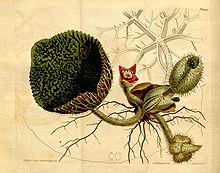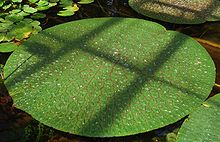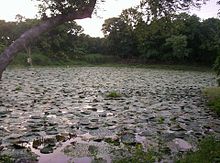Euryale ferox
| Euryale ferox | |
|---|---|

| |
| Flowering Euryale ferox cultivated in the Botanischer Garten Berlin-Dahlem | |

| |
| Botanical illustration of Euryale ferox from Curtis's Botanical Magazine (1812). | |
| Scientific classification | |
| Kingdom: | Plantae |
| Clade: | Tracheophytes |
| Clade: | Angiosperms |
| Order: | Nymphaeales |
| Family: | Nymphaeaceae |
| Genus: | Euryale Salisb. |
| Species: | E. ferox
|
| Binomial name | |
| Euryale ferox | |
| Synonyms[2] | |
| |



Euryale ferox, commonly known as prickly waterlily,[3] makhana or Gorgon plant, is a species of water lily found in southern and eastern Asia, and the only extant member of the genus Euryale.[a] The edible seeds, called fox nuts or makhana when dried,[b] are eaten in Asia.
Taxonomy[edit]
Euryale ferox is a member of the water lily family Nymphaeaceae.[2] The separate family Euryalaceae J.Agardh was proposed in 1858, a classification which has ultimately been rejected.[4] Unlike other water lilies, the pollen grains of Euryale have three nuclei.[5]
Etymology[edit]
The genus is named after a mythical Greek Gorgon, Euryale.[6]
The specific epithet ferox means fierce or ferocious.[7][8][9][10]
Distribution[edit]
Euryale ferox is a perennial plant native to eastern Asia and southern Asia, and is found from northeast India[c] to Korea and Japan, as well as parts of eastern Russia.
Recently, it has also been recorded in Serbia, Europe. It was likely dispersed to Serbia through migrating birds.[11]
Description[edit]
This section needs additional citations for verification. (November 2021) |
It grows in water, producing bright purple flowers. The leaves are large and round and peltate, often more than a meter (3 feet) across, with a leaf stalk attached in the centre of the lower surface. The underside of the leaf is purplish, while the upper surface is green. The leaves have a quilted texture, although the stems, flowers, and leaves which float on the surface are covered in sharp prickles. Other leaves are submerged. In India, Euryale normally grows in ponds and wetlands.
Reproduction[edit]
Self pollination can occur in Euryale ferox. Pollen is known to be released prior to the opening of the flower.[12] The majority of Euryale ferox flowers are cleistogamous, with the additional occurrence of chasmogamous flowers.[13]
Cytology[edit]
The chromosome count is n = 29. The genome size is 870.42 Mb.[14]
Uses[edit]
This section needs additional citations for verification. (March 2019) |
Culinary[edit]

The plant produces starchy white seeds that are edible. The plant is cultivated for its seeds[15] in lowland ponds in India, China, and Japan. The Chinese have cultivated the plant for centuries.[16] More than 96,000 hectares of Bihar, India, were set aside for cultivation of Euryale in 1990–1991.[6] The Indian state of Bihar produces 90% of the world's fox nuts.[15] The plant grows best in locations with hot, dry summers and cold winters. Seeds are collected in the late summer and early autumn, and may be eaten raw or cooked.
In the northern and western parts of India, Euryale ferox seeds are often roasted or fried, which causes them to pop like popcorn.[17] These are then eaten, often with a sprinkling of oil and spices. They are also used in other types of cooking, especially to make a porridge or pudding called kheer.
Evidence from archaeobotany indicates that Euryale ferox was a frequently collected wild food source during the Neolithic period in the Yangtze region, with large numbers of finds coming from the sites of Kuahuqiao, Hemudu, and Tianluoshan.[18] The earliest recorded use of E. ferox was found in Gesher Benot Ya'aqov, Israel, among artifacts of the Acheulean culture 750–790,000 years ago.[19]
The seeds are used in Cantonese soup.[20]
Traditional medicine[edit]
The seeds of foxnut are used in Ayurveda preparations and in traditional Chinese medicine.[15]
Conservation status[edit]
It is classified on the Red List of endangered plants in Japan and given the designation "vulnerable".[13][21] It is classified as species of Least Concern (LC) by the IUCN Red List of Threatened Species.[1] However, a population decline on the global scale has been reported.[13]
Notes[edit]
- ^ The plant is also called foxnut. Known as thangjing in parts of Manipur, India.
- ^ Also called gorgon nut.
- ^ Euryale is found in the Mithila region, specifically nine districts of Bihar (Madhubani, Darbhanga, Katihar, Sitamarhi, Purnea, Kishanganj, Araria, Saharsa and Supaul) and some hilly areas of Manipur.
References[edit]
- ^ a b Zhuang, X. 2011. Euryale ferox. The IUCN Red List of Threatened Species 2011: e.T168756A6535154. https://dx.doi.org/10.2305/IUCN.UK.2011-2.RLTS.T168756A6535154.en. Accessed on 03 August 2023.
- ^ a b "Euryale ferox Salisb". Plants of the World Online. Royal Botanic Gardens, Kew. Retrieved 26 July 2023.
- ^ Lee, Sangtae; Chang, Kae Sun, eds. (2015). English Names for Korean Native Plants (PDF). Pocheon: Korea National Arboretum. p. 466. ISBN 978-89-97450-98-5. Retrieved 7 March 2019 – via Korea Forest Service.
- ^ Euryalaceae J.Agardh, 1858. (n.d.). GBIF | Global Biodiversity Information Facility. Retrieved August 6, 2023, from https://www.gbif.org/species/206275338
- ^ Cronquist, Arthur (1981). An Integrated System of Classification of Flowering Plants. New York: Columbia University Press. p. 111. ISBN 978-0-231-03880-5.
- ^ a b Lariushin, Boriss (2012). Solanaceae family. Boriss Lariushin. p. 17. ISBN 9781478191834.
- ^ Datura ferox. (n.d.). New Zealand Plant Conservation Network. Retrieved February 2, 2024, from https://www.nzpcn.org.nz/flora/species/datura-ferox/
- ^ Urtica ferox. (n.d.). New Zealand Plant Conservation Network. Retrieved February 2, 2024, from https://www.nzpcn.org.nz/flora/species/urtica-ferox/
- ^ San Diego Zoo Global Library staff. (n.d.). LibGuides: Fossa (Cryptoprocta ferox) Fact Sheet: Taxonomy & History. Retrieved February 2, 2024, from https://ielc.libguides.com/sdzg/factsheets/fossa/taxonomy
- ^ Chen, W., Van Wyk, B. E., Vermaak, I., & Viljoen, A. M. (2012). "Cape aloes — A review of the phytochemistry, pharmacology and commercialisation of Aloe ferox." Phytochemistry Letters, 5(1), 1-12.
- ^ Živković, M., Pejčić, L., Paskaš, N., Bajić, A., Šipoš, Š., Perić, R., & Novakovic, B. (02 2023). "First recent record of Prickly Waterlily (Euryale ferox) Salisb. (Nymphaeaceae) in freshwaters of Europe."
- ^ Povilus, R. A., Losada, J. M., & Friedman, W. E. (2015). "Floral biology and ovule and seed ontogeny of Nymphaea thermarum, a water lily at the brink of extinction with potential as a model system for basal angiosperms." Annals of Botany, 115(2), 211-226.
- ^ a b c Imanishi, A., & Imanishi, J. (2014). "Seed dormancy and germination traits of an endangered aquatic plant species, Euryale ferox Salisb.(Nymphaeaceae)." Aquatic botany, 119, 80-83.
- ^ Chen, Fei; Liu, Xing; Yu, Cuiwei; Chen, Yuchu; Tang, Haibao; Zhang, Liangsheng (2017). "Water lilies as emerging models for Darwin's abominable mystery" (PDF). Horticulture Research. 4 (1): 17051. Bibcode:2017HorR....417051C. doi:10.1038/hortres.2017.51. PMC 5626932. PMID 28979789.
- ^ a b c Flora of China, "Euryale ferox"
- ^ Mabberley, D. J. (1987). The Plant-book. Cambridge: Cambridge University Press. ISBN 978-0-521-34060-1.
- ^ "Are popped lotus seeds the next popcorn?". Foodnavigator. 25 April 2018. Retrieved 2021-03-18.
- ^ Fuller, D. Q.; Qin, L; Zheng, Y; Zhao, Z; Chen, X; Hosoya, LA; Sun, GP; et al. (2009). "The Domestication Process and Domestication Rate in Rice: Spikelet bases from the Lower Yangtze". Science. 323 (5921): 1607–1610. Bibcode:2009Sci...323.1607F. doi:10.1126/science.1166605. PMID 19299619. S2CID 21357179.
- ^ Goren - Inbarand, N.; Melamed, Y.; Zohar, I.; Akhilesh, K.; Pappu, S. (2014-10-11). "Beneath Still Waters - Multistage Aquatic Exploitation of Euryale ferox (Salisb.) during the Acheulian". Internet Archaeology (37). doi:10.11141/ia.37.1. Retrieved 16 October 2014.
- ^ Yujing Liu; et al. (2018). "Plants traditionally used to make Cantonese slow-cooked soup in China". Journal of Ethnobiology and Ethnomedicine. 14 (1): 4. doi:10.1186/s13002-018-0206-y. PMC 5769313. PMID 29334976.
- ^ Kumar, N., Rani, S., Kuamr, G., Kumari, S., Singh, I. S., Gautam, S., & Choudhary, B. K. (2019). "Physiological and biochemical responses of Makhana (Euryale ferox) to gamma irradiation." Journal of Biological Physics, 45, 1-12.
Further reading[edit]
- Jha, S.N. (1999). "Physical and Hygroscopic Properties of Makhana". Journal of Agricultural Engineering Research. 72 (2): 145–150. doi:10.1006/jaer.1998.0356.
- Verma, Arvind Kumar; Banerji, B. K.; Chakrabarty, Debasis; Datta, S. K. (2010). "Studies on Makhana (Euryale ferox Salisbury)". Current Science. 99 (6): 795–800. ISSN 0011-3891. JSTOR 24109608.
- Bhardwaj, Tarun (August 22, 2022). "Bihar Mithila Makhana awarded GI Tag! Know about this variety of Fox Nut and its benefits". Financial Express. The Indian Express.
External links[edit]
- IUCN Red List least concern species
- Flora of Korea
- Flora of China
- Flora of Bangladesh
- Flora of India
- Flora of Mongolia
- Flora of Japan
- Flora of Myanmar
- Flora of Taiwan
- Flora of Russia
- Medicinal plants of Asia
- Euryale
- Plants described in 1805
- Plants used in traditional Chinese medicine
- Taxa named by Richard Anthony Salisbury

